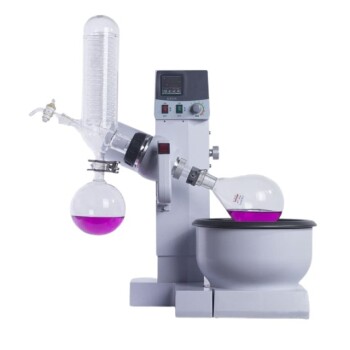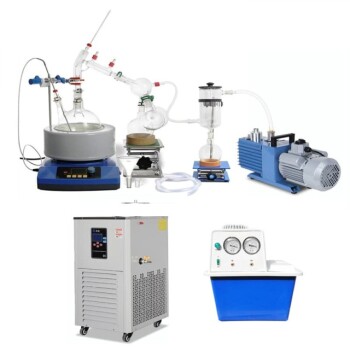
Rotary Evaporator
20L Rotary Evaporator Rotavapor Rotovap for Extraction Molecular Cooking Gastronomy and Laboratory Rotary Vacuum Evaporator Price Distillation
Item Number : KE-20
Price varies based on specs and customizations
- Evaporating Flask
- 20 L
- Flask Size
- ø125 mm
- Receiving Flask
- 10 L
- Condenser
- Vertical / Three Flow
- Vacuum Degree
- ≤2 kPa/h
- Rotating Speed
- 10-120 rpm

Shipping:
Contact us to get shipping details Enjoy On-time Dispatch Guarantee.
Applications
Rotary evaporator is an important equipment used in chemical laboratories of pharmaceutical, chemical, biological products and other industries, It uses the principles of constant temperature heating and thin film evaporating to implement evaporating, concentrating, crystallization, drying, separation, solvent recovery and other operations under vacuum negative pressure condition.
Rotary evaporation is most often and conveniently applied to separate "low boiling" solvents which are solid at room temperature and pressure, It can remove of solvents from samples by evaporation with high efficient and gentle features.
KT rotary evaporator applies selected materials to guarantee working performance, Telflon+Viton vacuum sealing reduce the pressure leaking risks, high grade borosilicate glassware enhance the service lifespan significantly, PTFE valves eliminate the reaction or contamination with sample samples. Also water bath modular designing, make the equipment more flexible to replacing or upgrading, safety protection methods are very considerate to prevent the mis-operation conditions,such as dry running,over temperature and ground power failures.
Features
- Compact and modular designing, occupy less space, flexible replacing and upgrading
- Vacuum sealing adopts Telflon+Viton double sealing method,high vacuum maintaining
- PTFE valve material prevent reacting with samples, keep the purity of sample material
- Stable rotating, stepless speed regulator makes rotating control more accurate
- PID thermal controller makes water bath temperature more constant,no over fluctuation
- Multiple safety protections for dry running,over temperature and ground power failures
- Optional transparent glassware protection cover to prevent the hot liquid splashing out
Technical specifications
| Model | KRE-2020Z |
| Evaporating Flask | 20L |
| Flask Size | ø125mm |
| Receiving Flask | 10L |
| Condenser | Vertical/Three Flow |
| Vacuum Degree | ≤2kPa/h |
| Vacuum Sealing | Telflon+Viton Sealing |
| Speed Control | Knop Stepless Speed Regulation |
| Rotating Speed | 10-120rpm |
| Rotating Power | 125W |
| Heating Power | 4KW |
| Heating Range | 0-99℃ |
| Temperature Accuracy | ±2℃ |
| Lifting Method | Electric |
| Lifting Distance | 200mm |
| Anti-splash Device | PP Transparent Cover (Optional) |
| Safty Protection | Over-current/ ground fault/over-temperature protection |
| Power supply | 110-240V, 50/60Hz |
| Working Environment | 5-35℃ |
| Dimensions | 850*520*160mm |
| Weight | 90Kg |
Warnings
Operator safety is the top important issue! Please operate the equipment with cautions. Working with inflammable& explosive or toxic gases is very dangerous, operators must take all necessary precautions before starting the equipment. Working with positive pressure inside the reactors or chambers is dangerous, operator must fellow the safety procedures strictly. Extra caution must also be taken when operating with air-reactive materials, especially under vacuum. A leak can draw air into the apparatus and cause a violent reaction to occur.
Designed for You
KinTek provide deep custom made service and equipment to worldwide customers, our specialized teamwork and rich experienced engineers are capable to undertake the custom tailoring hardware and software equipment requirements, and help our customer to build up the exclusive and personalized equipment and solution!
Would you please drop your ideas to us, our engineers are ready for you now!
FAQ
What Is The Purpose Of A Rotary Evaporator?
Why Rotary Evaporator Is Used In Solvent Extraction?
Can Rotary Evaporator Remove Water?
Is Rotary Evaporator Used For Distillation?
What Are The Principles Of Rotary Evaporation?
What Are The Advantages Of A Rotary Evaporator?
4.8
out of
5
The adjustable speed feature is a lifesaver when working with different chemicals.
4.9
out of
5
The powerful motor ensures efficient evaporation even under high pressure.
4.7
out of
5
The large collection flask capacity makes it perfect for large-scale projects.
4.8
out of
5
The vacuum system creates a stable environment for precise evaporation.
4.7
out of
5
The durability of this rotary evaporator is impressive, ensuring long-lasting performance.
4.9
out of
5
The easy-to-use LCD screen makes controlling the device a breeze.
4.8
out of
5
The high-efficiency glass condenser effectively cools the solvent vapor.
4.7
out of
5
The compact and modular design saves valuable lab space.
4.9
out of
5
The advanced safety features provide peace of mind during operation.
4.8
out of
5
The PTFE valves prevent contamination of the sample.
4.7
out of
5
The adjustable speed range allows for precise control of the evaporation process.
4.9
out of
5
The double condensers ensure excellent sealing and high recovery rate.
4.8
out of
5
The stable rotating speed ensures consistent evaporation results.
4.7
out of
5
The optional transparent glassware protection cover prevents hot liquid splashing.
4.9
out of
5
The electric lifting method makes it easy to adjust the height of the flask.
4.8
out of
5
The wide range of applications makes this rotary evaporator a versatile tool.
4.7
out of
5
The energy-saving design reduces operating costs.
REQUEST A QUOTE
Our professional team will reply to you within one business day. Please feel free to contact us!
Related Products

Efficiently remove low boiling solvents with the KT 2-5L Rotary Evaporator. Perfect for chemical labs in the pharmaceutical, chemical, and biological industries.

Efficiently separate low boiling solvents with KT Rotary Evaporator. Guaranteed performance with high-grade materials and flexible modular design.

20L Short Path Distillation Unit System Vacuum Evaporator
Efficiently extract and purify mixed liquids with our 20L short path distillation system. High vacuum and low temperature heating for optimal results.

Laboratory Vertical Water Circulating Vacuum Pump for Lab Use
Looking for a reliable water circulating vacuum pump for your lab or small-scale industry? Check out our Vertical Water Circulating Vacuum Pump with five taps and a larger air sucking amount, perfect for evaporation, distillation, and more.

Laboratory Benchtop Water Circulating Vacuum Pump for Lab Use
Need a water circulating vacuum pump for your lab or small-scale industry? Our Benchtop Water Circulating Vacuum Pump is perfect for evaporation, distillation, crystallization, and more.

5L Short Path Distillation Unit System Vacuum Evaporator
Experience efficient and high-quality 5L short path distillation with our durable Borosilicate glassware, fast heating mantle, and delicate fitting device. Extract and purify your target mixed liquids with ease under high vacuum conditions. Learn more about its advantages now!

Custom PTFE Teflon Parts Manufacturer for Culture Dish and Evaporation Dish
The PTFE culture dish evaporating dish is a versatile laboratory tool known for its chemical resistance and high-temperature stability. PTFE, a fluoropolymer, offers exceptional non-stick properties and durability, making it ideal for various applications in research and industry, including filtration, pyrolysis, and membrane technology.

Electron Beam Evaporation Coating Gold Plating Tungsten Molybdenum Crucible for Evaporation
These crucibles act as containers for the gold material evaporated by the electron evaporation beam while precisely directing the electron beam for precise deposition.

Tungsten and molybdenum crucibles are commonly used in electron beam evaporation processes due to their excellent thermal and mechanical properties.

E Beam Crucibles Electron Gun Beam Crucible for Evaporation
In the context of electron gun beam evaporation, a crucible is a container or source holder used to contain and evaporate the material to be deposited onto a substrate.

Thermally Evaporated Tungsten Wire for High Temperature Applications
It has a high melting point, thermal and electrical conductivity, and corrosion resistance. It is a valuable material for high temperature, vacuum and other industries.

High Purity Pure Graphite Crucible for Evaporation
Vessels for high temperature applications, where materials are kept at extremely high temperatures to evaporate, allowing thin films to be deposited on substrates.

Inclined Rotary Plasma Enhanced Chemical Vapor Deposition PECVD Equipment Tube Furnace Machine
Upgrade your coating process with PECVD coating equipment. Ideal for LED, power semiconductors, MEMS and more. Deposits high-quality solid films at low temps.

Electric Rotary Kiln Pyrolysis Furnace Plant Machine Calciner Small Rotary Kiln Rotating Furnace
Electric rotary kiln - precisely controlled, it's ideal for calcination and drying of materials like lithium cobalate, rare earths, and non-ferrous metals.

Laboratory Vacuum Tilt Rotary Tube Furnace Rotating Tube Furnace
Discover the versatility of Laboratory Rotary Furnace: Ideal for calcination, drying, sintering, and high-temperature reactions. Adjustable rotating and tilting functions for optimal heating. Suitable for vacuum and controlled atmosphere environments. Learn more now!

Inclined Rotary Plasma Enhanced Chemical Vapor Deposition PECVD Equipment Tube Furnace Machine
Introducing our inclined rotary PECVD furnace for precise thin film deposition. Enjoy automatic matching source, PID programmable temperature control, and high accuracy MFC mass flowmeter control. Built-in safety features for peace of mind.

Efficient split chamber CVD furnace with vacuum station for intuitive sample checking and quick cooling. Up to 1200℃ max temperature with accurate MFC mass flowmeter control.

80-150L Jacketed Glass Reactor Vessel for Lab Applications
Looking for a versatile jacket glass reactor system for your lab? Our 80-150L reactor offers controlled temperature, speed, and mechanical functions for synthetic reactions, distillation, and more. With customizable options and tailored services, KinTek has you covered.
Related Articles

Distilling Liquids Using a Rotovap A Step-by-Step Guide
Distilling liquids is a process that has been used for centuries. The traditional method of distillation can be time-consuming and requires a lot of energy.

Discover The Benefits of Using A Rotary Evaporator
Rotary evaporators are essential laboratory equipment used in the process of separating solvents from samples. These devices work by evaporating the solvent from the sample under a reduced pressure and controlled temperature.

What Is Rotary Evaporator Used For?
A rotary evaporator (or rotavap/rotovap) is a device used in chemical laboratories for the efficient and gentle removal of solvents from samples by evaporation.

From Lab to Kitchen The Versatile Applications of Rotary Evaporator
A rotary evaporator, also known as a rotovap, is a laboratory device used for separating solvents from samples using evaporation. The device consists of a rotating flask and a condenser that is cooled by either air or water.

From Chemistry to Cooking The Versatility of Rotary Vacuum Evaporator
A rotary vacuum evaporator is a laboratory equipment that uses a rotating flask to remove solvents from a sample. It works by creating a vacuum in the system, which lowers the boiling point of the solvent and allows it to evaporate at lower temperatures.

Choosing the Right Rotary Vacuum Evaporator for Your Lab
Rotary vacuum evaporators are essential tools for any laboratory that needs to concentrate or isolate solutions. These devices work by heating a sample under vacuum to increase its surface area and effectively remove solvent.

Advantages of Using a Rotary Evaporator for Solvent Removal
Rotary evaporators are laboratory instruments used for solvent removal. They work by rotating a flask containing a liquid sample, which creates a thin film on the surface of the flask.

How To Use A Rotary Evaporator
Rotary evaporators (also called "rotavaps") are used to remove solvents from reaction mixtures and can accommodate volumes as large as 3 liters.

5 Essential Applications of Rotary Evaporator in Labs
Rotary evaporators, also known as rotovaps, are laboratory instruments used for distillation, concentration, and purification of samples. They are widely used in the chemical, pharmaceutical, and food and beverage industries for various applications.

How Rotary Evaporators are Revolutionizing Distillation
Rotary evaporators, also commonly referred to as rotovaps, are laboratory equipment used for the separation of solvents from a mixture through the process of distillation.

Understanding the Basics of a Rotary Evaporator
The rotary evaporator is a versatile and widely used tool in the laboratory for separating solvents from compounds.

How Rotary Evaporators Help in Separation Processes
Rotary evaporators, or rotovaps, are laboratory equipment used in separation processes to remove solvents from samples.